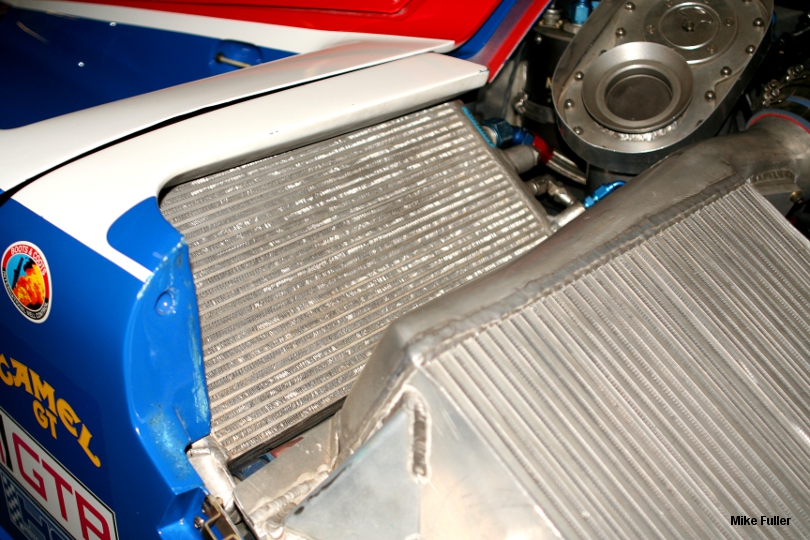 The
placement of the GTP ZX-T's radiators, as well as the source of the cooling air flow, carried over from the Nissan Lola
810. The left hand (right side of image) side pod houses a
staggered
arrangement with the oil cooler perching forward of and above the turbo
intercooler. The large water cooler resides in the right hand
side pod and the air flow to it is split between the leading edge nose
inlet and the side pod inlet. The
placement of the GTP ZX-T's radiators, as well as the source of the cooling air flow, carried over from the Nissan Lola
810. The left hand (right side of image) side pod houses a
staggered
arrangement with the oil cooler perching forward of and above the turbo
intercooler. The large water cooler resides in the right hand
side pod and the air flow to it is split between the leading edge nose
inlet and the side pod inlet.
|
 The
cooling ducts route either side of the monocoque and through the doors.
The front air jack intrudes into this space and has a teardrop
shaped cover to mitigate its effects on the airflow. The
cooling ducts route either side of the monocoque and through the doors.
The front air jack intrudes into this space and has a teardrop
shaped cover to mitigate its effects on the airflow. |
 The
staggered radiator arrangement is evident here, oil on top, intercooler
behind and slightly below. One of the many benefits of the GTP
ZX-T (and the original Lola it must be said) was its ability
to draw in ample airflow to keep the Nissan VG30 engine cool. The
staggered radiator arrangement is evident here, oil on top, intercooler
behind and slightly below. One of the many benefits of the GTP
ZX-T (and the original Lola it must be said) was its ability
to draw in ample airflow to keep the Nissan VG30 engine cool. |
 On
the Nissan Lola 810, once through the coolers, air exited the car from
large exit ducts in the horizontal face of the side pods just ahead of
the rear wheels. Yoshi Suzuka rerouted the exit so that air flow
exiting the intercooler and the water radiator went out these new
triangular shaped ducts located in the vertical face of the side pod
just ahead of the rear wheels. On
the Nissan Lola 810, once through the coolers, air exited the car from
large exit ducts in the horizontal face of the side pods just ahead of
the rear wheels. Yoshi Suzuka rerouted the exit so that air flow
exiting the intercooler and the water radiator went out these new
triangular shaped ducts located in the vertical face of the side pod
just ahead of the rear wheels.
Rerouting the air out the sides
improved L/D, but interestingly there was a secondary benefit
too, says Suzuka, "I always watch L/D, this is the top priority...this
way, the rear wing will get cleaner air and at the same time I could
lower the wing location. If you can lower the rear wing, it helps
CG height...The rear wing's contribution to the CG height is quite big." |
 The
exit for the oil cooler was unchanged from the Lola 810 and went out a
small exit duct in the top of the rear bodywork just ahead of
the rear wheel. The
exit for the oil cooler was unchanged from the Lola 810 and went out a
small exit duct in the top of the rear bodywork just ahead of
the rear wheel. |
